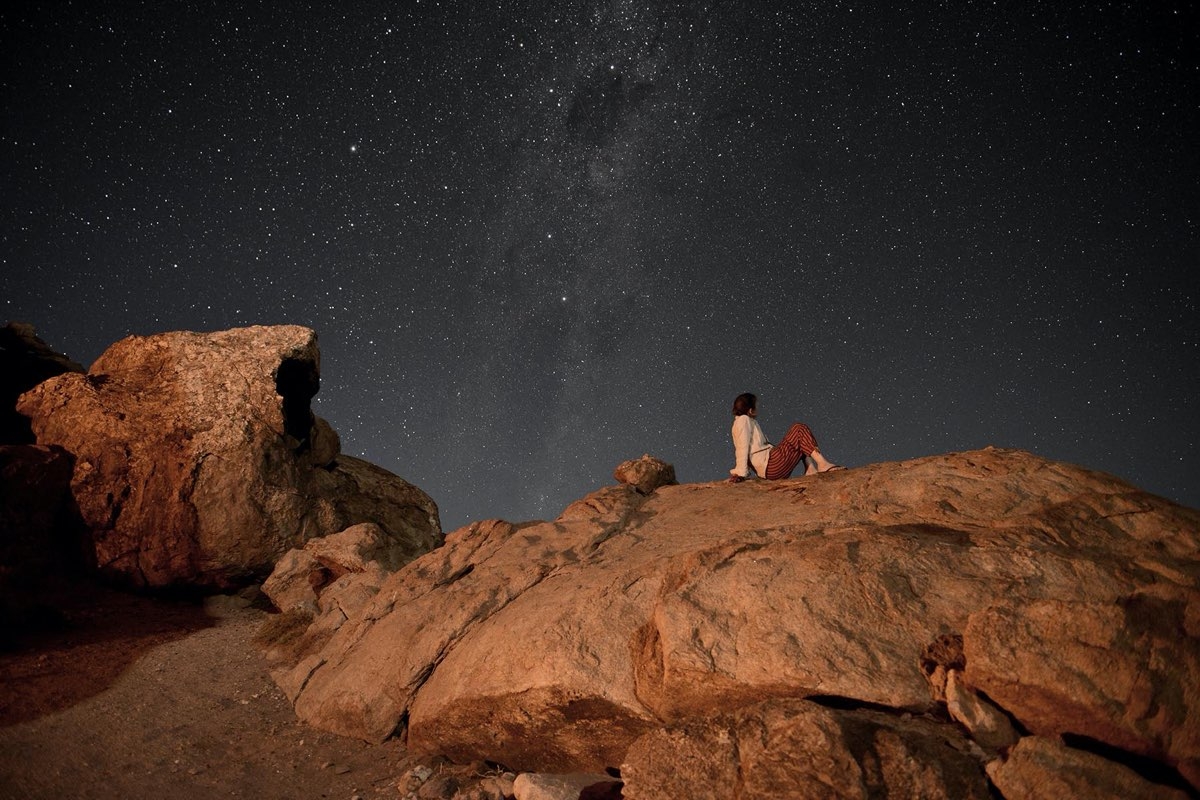I feel as if I’ve stepped into an abstract painting. The landscape is composed of three stripes of intense color—off-white, rusty orange, and a rich blue. Clay, sand, sky. In the foreground, the skeletal forms of long-dead trees—just trunks and branches, no leaves or twigs—lend a surreal touch. No wind blows; no bird calls. The place is silent. Still. Apart from my husband and myself, there is no one.
We’re in Dead Vlei, one of the most celebrated places in the great sand sea of the Namib Desert, in southern Africa. Vlei is Afrikaans for “seasonal pool.” Centuries ago, a river flowed here, and the trees grew. Then the river changed its course, leaving the trees to die. Because the climate is so dry, they didn’t rot, so they stand here still, ancient relics surrounded by some of the planet’s largest and most spectacular sand dunes.
Free of Anthropic Confections
Namibia is a good place to contemplate the infinite. In the language of the Nama people, who have lived here for centuries, namib means “vast deserted place.” Today, the country is larger than Texas but has a population of just 2.6 million, which is less than that of Chicago. Much of the landscape is empty of humans; the horizon is often free of buildings, power lines, or other anthropic confections. The sparse vegetation brings geology to the fore, the upheaved, folded rocks revealing the brutal might of the Earth and the slow drama of passing eons.
I reflected on all this at a place called Mirabib, a gigantic rock that stands in the middle of a flat gravel plain that stretches to the horizon. I say “rock,” but it’s actually a half-mile-long remnant of a mountain range that formed more than 500 million years ago. That was a time before dinosaurs, before forests, before animals had begun to live on land. Now, weathering has turned the rock into a sort of onion—the friable outer layer is not firmly attached to the layer below, and gives an odd, hollow noise when you knock on it. Above, the night sky, unspoiled by city lights, is awesome, the density of stars so great that I find it hard to pick out familiar constellations.

One of the first Europeans to travel in these parts was none other than Charles Darwin’s cousin, Francis Galton. Often described as a polymath, Galton would go on to invent weather maps, study fingerprints, and make fundamental contributions to statistics. At the same time, though, he would become preoccupied with human intelligence and racial differences. He coined the phrase “nature and nurture,” as well as the term “eugenics,” which is derived from Greek for “well born.” But in August of 1850, when he disembarked at what is now the Namibian port of Walvis Bay—“the shores of which were dancing with mirage, and presented the appearance of the utmost desolation,” a description that still holds today—all that was in the future.
Galton coined the phrase “nature and nurture,” as well as the term “eugenics.”
Reading his adventures—which he published in 1853, soon after returning to London—I find myself besieged by conflicting emotions. No doubt, he was intrepid: just 28 when the journey began, he led people, oxen, horses, and mules hundreds of miles across (to Europeans) uncharted terrain, surveying and making maps as he did so. Soon after his arrival, lions ate one of his mules; as the journey wore on, he struggled through ravines, and bushes thick with thorns.
The flat tire that my husband and I changed against a backdrop of fading light and wild zebras pales in comparison: “The oxen were dreadfully wild; there was no guiding or restraining them down hill, but they tossed themselves about and charged like wild buffaloes”; “I had been hoping to see fewer thorn-trees, but here they were worse than ever. My oxen would not face them: a single bush threw the whole team into confusion: the oxen plunged and tossed, and got their heads out of the yokes…. Our clothes and hands were sadly torn … ”
The text is also full of practical information, such as how to make soap, or the best way to carry an azimuth compass (hung about your person so it sits in the small of your back). Galton studied the local languages; he was also prompt to emulate skills he admired. “As to carrying guns on horseback, nobody that I am aware of, except a Hottentot, and occasionally a Dutchman, knows how to do it,” he says, before embarking on a detailed description of their technique. Most remarkably, on the basis of his observations of animals, he makes a proposal for the broken lines and mottled patterns of modern camouflage clothing decades before that was the norm.
A Haven for Lions, Elephants, and Rhinos
But while I admire his energy, courage, curiosity, and insights, I cannot like the man himself. Where cousin Charles ends The Voyage of the Beagle, an account of his five-year circumnavigation of the globe, with a vigorous denunciation of slavery, cousin Francis is more prone to thinking “these savages court slavery.” Where cousin Charles doesn’t mention whipping except to intervene, cousin Francis is perpetually considering whipping this person or that one, or actually doing so. Of the local Damara people, he complains, “This deference of husband to wife was a great difficulty in the way of discipline; for I often wanted to punish the ladies of my party, and yet I could not make their husbands whip them for me, and of course I was far too gallant to have it done by other hands.” Three cheers for the husbands.
Today, Galton’s name graces the western gate of Etosha National Park, a vast wildlife preserve. As we drive through, my mind floats over the irony of a haven for lions, elephants, and rhinos, as well as other magnificent creatures, being named for a man who killed so many of them—despite his protestations that “I really do not much care about shooting the animals … it is the least pleasurable part of the whole” and his claim that he’d prefer to spend the night perched in a tree, just to watch. Why didn’t he, then?

But never mind such petty considerations: we’re here to connect with the cosmos. That’s why we’ve made a detour to a small outdoor amphitheater, about 100 miles southeast of Etosha, and a short drive from the bustling town of Grootfontein. But no actor swaggers on this stage. Instead, at the center of the space, a huge hunk of metal lies in state: Hoba, the largest intact meteorite ever found. About the size of a small car, the top surface is roughly rectangular, and each side is longer than I am tall.
A huge hunk of metal lies in state: Hoba, the largest intact meteorite ever found—about the size of a small car
The meteorite became known to Europeans around 100 years ago, when a farmer noticed part of its blackened, pitted surface just level with the ground. He scratched his head, and thought, That’s funny, this doesn’t look like any of the other rocks around here. So he chiseled out a piece, revealing shiny metal, which he took to Grootfontein for analysis; his wife, meanwhile, helped to excavate the slab. Compared to the whitish limestone and pale dust all around, it definitely looks out of place. But if it had been me, stumbling around in the bush, would I have had the wit to realize the oddity? I’m not sure.
Subsequent investigation has shown that this is a fragment of the solar system’s earliest days, a tangible leftover of the time the planets formed, more than 4.5 billion years ago. Despite its great age, Hoba is thought to have fallen to Earth recently, geologically speaking—which is to say, a mere 80,000 years ago. Humans were already living in this part of Africa, so someone might have seen it fall.
For a 60-ton slab of iron and nickel crashing in from outer space, it appears to have landed rather gently; if it made an impact crater, that has long since eroded away. Unlike the far more enormous object that slammed into the Earth around 65 million years ago, bringing the days of the dinosaurs to a close, the landing of this meteorite appears not to have had a global effect. All the same … imagine seeing something like this, ablaze from the friction of the air, hurtling through the sky.
As we walk back to the car, through a small botanical garden, past a sign that says, in English and German, “Beware of falling meteorites,” I find myself thinking that I have rarely visited a country so rich in vistas and timescapes, where so many layers of planetary history are so majestically displayed. I had always known Namibia would be beautiful. But now I feel like a latter-day pilgrim, come to pay homage to the Earth.
Olivia Judson is an evolutionary biologist and writer based in Berlin








